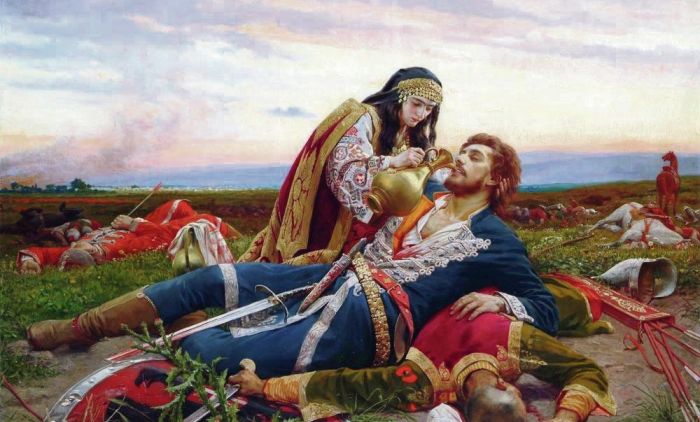
The Kosovo Maiden or Maiden of the Blackbird’s Field (Serbian Cyrillic: „Косовка девојка“-romanized:“ Kosovka devojka„) is the central figure of a poem with the same name, part of the Kosovo cycle in the Serbian epic poetry. In it, a young beauty searches the battlefield for her betrothed fiancé. She helped wounded Serbian warriors with water, wine, and bread after the Battle of Kosovo in 1389 between Serbia and the Ottoman Empire. She finally finds the injured and dying warrior Pavle Orlović who tells her that her fiancé Milan Toplica and his blood-brothers Miloš Obilić and Ivan Kosančić are dead. Before the battle they had given her a cloak, golden ring, and veil for the wedding as a promise of safe return, but they were slain and Pavle pointed to the direction of the bodies. The poem finishes with:
„O wretch! Evil is your fortune!
If I, a wretch, were to grasp a green pine,
Even the green pine would wither.“
The poem became very popular as a symbol of womanly compassion and charity. Serbian painter Uroš Predić took up the theme in 1919 with an oil painting of the same title. In 1907, Croatian sculptor Ivan Meštrović created a marble relief of the subject as a part of his Kosovo cycle.
Serbian Monasteries and Churches in Kosovo
Kosovo is home to some of the most significant Serbian Orthodox monasteries and churches, representing centuries of cultural, religious, and architectural heritage. These sacred sites, dating back to the medieval period, stand as living testaments to the Serbian people’s spiritual history and artistic achievements. Many of these landmarks are UNESCO World Heritage Sites, protected for their universal cultural value.
Sacred Monasteries
The Serbian monasteries in Kosovo are not just places of worship but also centers of art and history. They showcase Byzantine-inspired frescoes, iconography, and intricate architectural designs. These monasteries have withstood the test of time, surviving wars and natural disasters, and continue to serve as places of prayer and pilgrimage.
Notable Monasteries
- Banjska Monastery – A 14th-century endowment of King Stefan Milutin.
- Devič Monastery – Renowned for its miraculous healing powers.
- Gračanica Monastery – A UNESCO World Heritage Site and a masterpiece of Serbian medieval architecture.
- Patriarchate of Peć Monastery – The spiritual seat of the Serbian Orthodox Church.
- Visoki Dečani Monastery – Famous for its frescoes and well-preserved medieval art.
Explore more monasteries, including Sokolica Monastery and Draganac Monastery, each holding unique historical importance.
Full list of Serbian Monasteries
- Banjska Monastery
- Devič Monastery
- Gorioč Monastery
- Gračanica Monastery
- Patriarchate of Peć Monastery
- Sokolica Monastery
- Visoki Dečani Monastery
- Zočište Monastery
- Monastery of the Holy Archangels
- Draganac Monastery
- Deve Water Monastery
- Duboki Potok Monastery
- Sočanica Monastery
- Ubožac Monastery
- Uliya Monastery
- Brnjak Monastery
- Budisavci Monastery
- Vračevo Monastery
- Tamnica Monastery
- St. Mark of Koriša Monastery
- Holy Trinity Monastery in Mušutište
- Hermitage of St. Peter of Koriša
- Church of the Presentation of the Blessed Virgin Mary in Čitluk
Historic Churches
In addition to monasteries, Kosovo is dotted with Serbian Orthodox churches that echo the deep-rooted Christian traditions of the region. These churches bear witness to the faith and devotion of generations past and present.
Iconic Churches
- Church of the Holy Saviour, Prizren – Known for its rich frescoes and historical significance.
- Cathedral of Saint George, Prizren – A prominent symbol of Serbian Orthodoxy.
- Church of Saint Nicholas, Pristina – Preserving centuries-old traditions.
- Church of Saint George, Goraždevac – An important place of worship and cultural heritage.
Full list of Serbian churches
- Church of the Holy Saviour, Prizren
- Cathedral of Saint George, Prizren
- Church of Saint Nicholas, Prizren
- Church of Saint Nicholas, Đurakovac
- Church of Saint John the Baptist, Peć
- Church of the Presentation of the Virgin, Lipljan
- Church of Saint Apostles Peter and Paul, Suva Reka
- Church of Saint Nicholas, Pristina
- Church of Saint Demetrius, Suva Reka
- Church of Saint George, Pristina
- Church of Saint Nicholas, Gnjilane
- Church of Saint Sava, Kosovska Mitrovica
- Church of Saint Nicholas, Štimlje
- Church of Saint Nicholas, Donja Gušterica
- Church of Saint Nicholas, Prizren
- Church of Saint George, Prizren
- Church of Saint John, Velika Hoča
- Church of Saint Stephen, Donje Nerodimlje
- Church of Saint Nicholas, Osojane
- Church of Saint Nicholas, Pristina
- Church of Saint George, Goraždevac
- Church of Saint John the Baptist, Samodreža
- Church of Saint Nicholas, Štrpce
- Church of Saint Demetrius, Suva Reka
- Church of Saint Nicholas, Novo Brdo
- Church of Saint George, Pristina
- Church of Saint Nicholas, Gnjilane
- Church of Saint Sava, Kosovska Mitrovica
- Church of Saint Nicholas, Štimlje
- Church of Saint Nicholas, Donja Gušterica
- Church of Saint Nicholas, Prizren
- Church of Saint George, Prizren
- Church of Saint John, Velika Hoča
- Church of Saint Stephen, Donje Nerodimlje
- Church of Saint Nicholas, Osojane
- Church of Saint George, Goraždevac
Preserving the Heritage
The monasteries and churches of Kosovo are more than historical monuments; they are living symbols of faith, endurance, and identity. They continue to attract pilgrims, tourists, and researchers from all around the world, highlighting the region’s enduring legacy of Serbian culture.
Despite the challenges faced over the centuries, these religious sites remain standing, offering a glimpse into the rich history and spiritual depth of Serbian Orthodoxy.
Plan Your Visit
For those interested in exploring these remarkable landmarks, many monasteries and churches welcome visitors year-round. Whether you seek spiritual reflection or historical exploration, Kosovo’s sacred sites offer a profound and enriching experience.
Take the journey through time and discover the sacred treasures of Serbian heritage in Kosovo.